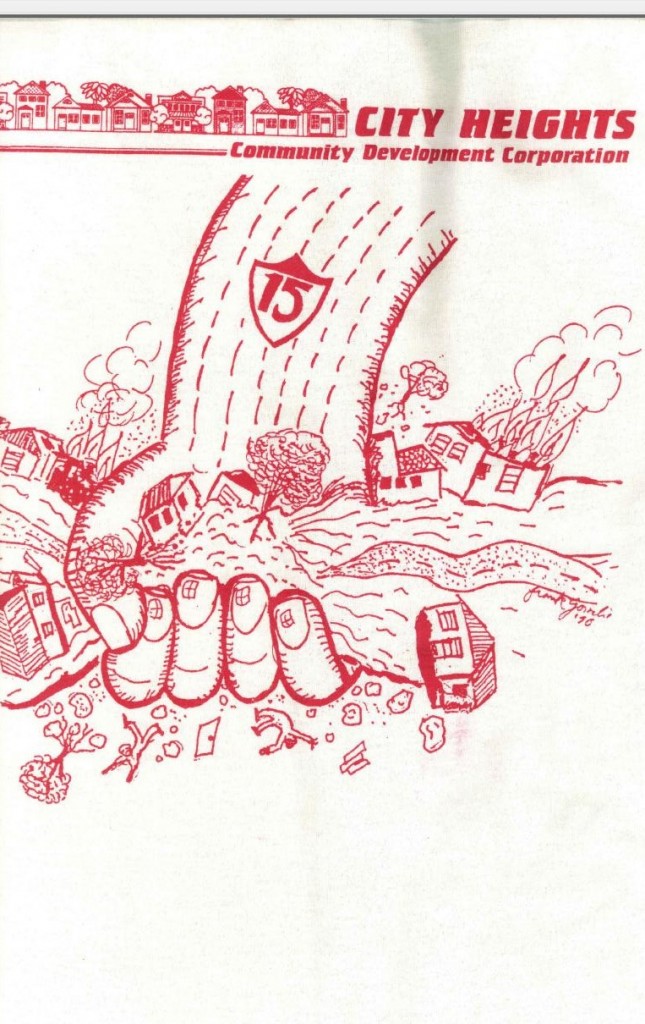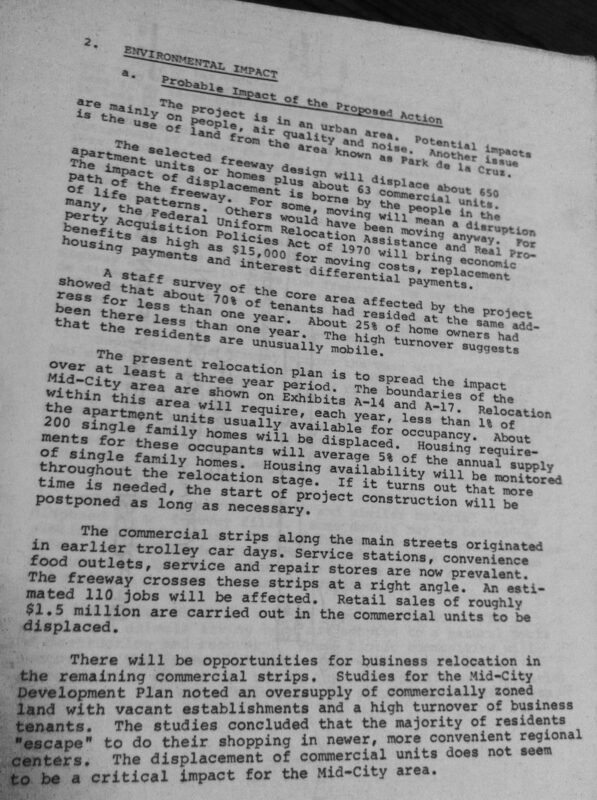For the Mid-City Community: Three Decades of Broken Promises

In late 1972, the California Department of Transportation (Caltrans) released a report detailing the impact that would result after the construction of I-15 (from I-805 to I-8, approximately 3 miles) through the heart of Mid-City, specifically the neighborhood of City Heights:

The project is in an urban area. Potential impacts are mainly on people, air quality and noise. Another issue is the use of land from the area known as Park de la Cruz.
The selected freeway design will displace about 650 apartment units or homes [Ed. note: displacing 2,000 people plus about 63 commercial units affecting 110 jobs and $1.5 million in annual taxable retail]. The impact of displacement is borne by the people in the path of the freeway. For some, moving will mean a disruption of life patterns. Others would have been moving away. For many, the Federal Uniform Relocation Assistance and Real Property Acquisition Policies Act of 1970 will bring economic benefits as high as $15,000 for moving costs, replacement housing payments and interest differential payments.
The report goes on to state:
The displacement of commercial units does not seem to be a critical impact for the Mid-City area.
Using logic that only a highway focused agency could come up with, the report goes on:
Exhaust emissions will be concentrated along the Route 15 corridor. Future traffic that would have used city streets or other highway routes will use the freeway. People working or residing along Route 15 will have better air quality after the freeway is constructed. However, this will be due to vehicle emission controls and the passage of time. It probably will not be due to the freeway.
Under the Federal Clean Air Amendments of 1970, the San Diego Air Basin will have to meet national ambient air quality standards by 1975. The freeway projects will not be completed in time to have any effect in meeting the 1975 deadline. By today’s standards, 1975 and later vehicles will be essentially “pollution free”. The number of pre-1975 models will decline with time; few will still be operating in 1986.
The report gets worse:
There will be noise impacts on the people remaining along the freeway corridor. From a community point of view, the freeway can probably be seen as a benefit. Noise levels at the closest homes will be lower than they are today. However, the people are not the same. Those living on the east side of Central Avenue, Terrace Drive and 39th Street will hear an adverse impact.
The destruction caused by the building of I-15 through City Heights may never fully be understood, but a documentary titled “The Price of Renewal” does give some light on the issue.
As depicted in The Price of Renewal, after the Caltrans announcement in the 1970s to build a freeway through City Heights, residents abandoned their homes and crimes began to rise contributing to a decline in overall quality of life.
Today, City Heights is finally turning a corner. After decades of advocacy by committed City Heights residents, the Centerline Bus Rapid Transit will finally be built (downgraded from a light rail line). Caltrans will finally be applying for funding to build the I-15 bike path from Adams Avenue to Camino del Rio South – fulfilling a promise made nearly three decades ago – that will connect the Mid-City Community to Mission Valley. And efforts are being made to eliminate the results of institutionalized neglect against a community made impoverished by former leaders too fixated on moving vehicles and building highways.

I do spend a considerable amount of time thinking about people like James D. Knochenhauer, the Regional Representative at the Bureau of Community Environmental Management, who in 1971 wrote a letter stating that the I-15 project wouldn’t cause “any problems of health significance”.
Today City Heights residents experience higher rates of asthma (than residents in the rest of the county) and a lack of access to transportation options despite only a third of the residents having access to an automobile.

I do wonder if individuals like Mr. Knochenhauer thought about the community of City Heights and how his letter of support contributed to decades of decline in a once vibrant and thriving community.
I wonder if he ever regretted writing that letter.
More on this topic here and here thanks to San Diego Free Press.
